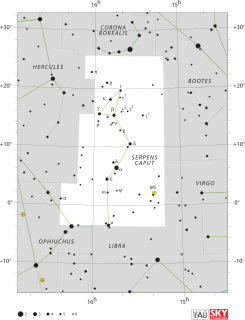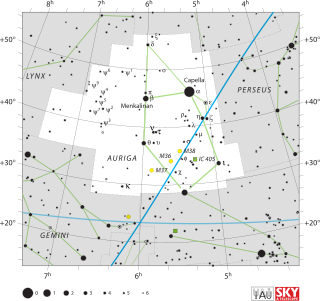Related Research Articles

Lambda Serpentis is a star in the constellation Serpens, in its head. It has an apparent visual magnitude of 4.43, making it visible to the naked eye. Based upon parallax measurements from the Hipparcos satellite, this star lies at a distance of about 39.5 light-years from Earth. This star is larger and more massive than the Sun, although it has a similar stellar classification. It is shining with nearly double the Sun's luminosity and this energy is being radiated from the star's outer atmosphere at an effective temperature of 5,884 K.

Pi Andromedae is the Bayer designation for a binary star system in the northern constellation of Andromeda. With an apparent visual magnitude of 4.4, it is visible to the naked eye. It is located approximately 600 light-years from Earth.

Rho Aquarii, Latinized from ρ Aquarii, is the Bayer designation for a binary star in the equatorial constellation of Aquarius. It is visible to the naked eye with an apparent visual magnitude of +5.34. Based upon parallax measurements made during the Hipparcos mission, this star is at a distance of roughly 880 light-years from Earth.

Upsilon Aquilae, Latinized from υ Aquilae, is the Bayer designation for a star in the equatorial constellation of Aquila. With an apparent visual magnitude of +5.91 it is a faint star but visible to the naked eye from suburban skies. It has an annual parallax shift of 18.65 milliarcsecond, indicating a distance of around 175 light-years.

Eta Arae, Latinized from η Arae, is the Bayer designation for a single star in the southern constellation of Ara. It is approximately 299 light-years from Earth and is visible to the naked eye with an apparent visual magnitude of 3.76. The star is moving away from the Sun with a radial velocity of +9 km/s.

Kappa Arietis, Latinized from κ Arietis, is the Bayer designation for a binary star in the northern constellation of Aries. The combined apparent visual magnitude of the pair is 5.02, making the system bright enough for it to be dimly visible to the naked eye as a white-hued point of light. It is located approximately 181 light years from the Sun based on parallax, and is drifting further away with a radial velocity of +11.5 km/s.

Chi Aurigae is the Bayer designation for a binary star in the northern constellation of Auriga. It is faintly visible to the naked eye with an apparent visual magnitude of 4.74. The annual parallax shift of this object is much smaller than the measurement error, making distance estimates by that means unreliable. The estimated distance to this star is approximately 3,000 light years. The brightness of the star is diminished by 1.26 in magnitude from extinction caused by intervening gas and dust.

101 Aquarii is a star in the equatorial constellation of Aquarius. 101 Aquarii is the Flamsteed designation, although it also bears the Bayer designation b3 Aquarii. The combined apparent visual magnitude of the pair is 4.71, which is bright enough to be seen with the naked eye from the suburbs. The distance of this star from Earth is estimated as 290 light-years based upon parallax measurements.

83 Aquarii is a binary star system in the equatorial constellation of Aquarius. 83 Aquarii is its Flamsteed designation, though it also bears the Bayer designation of h Aquarii. The combined apparent visual magnitude of the pair is 5.43, which is faintly visible to the naked eye. Based upon an annual parallax shift of 15.57 milliarcseconds, it is located at a distance of around 209 light-years from Earth.

18 Aquilae is a triple star system in the constellation of Aquila. 18 Aquilae is the Flamsteed designation; it also bears the variable star designation Y Aquilae. It has an apparent visual magnitude of 5.07. The distance to this system can be estimated from the annual parallax shift of 6.43 mas, yielding a value of around 510 light-years away from Earth.
57 Aquilae is a double star in the constellation of Aquila. 57 Aquilae is its Flamsteed designation. The primary star has an apparent visual magnitude of 5.70, while the secondary is magnitude 6.48. The pair have an angular separation of 35.624 arcseconds and probably form a wide binary star system. The estimated distance of the first component is 480 light-years, while the second is at 510 light-years. However, the margin of errors for their respective distance estimates overlap, indicating a probability that they are actually located much closer to each other. Both stars are massive, B-type main sequence stars with rapid rotation rates.
56 Aquilae is a single star in the equatorial constellation of Aquila. 56 Aquilae is its Flamsteed designation. Its apparent visual magnitude is 5.79, meaning it is barely visible to the naked eye as a dim, orange-hued point of light, under ideal viewing conditions. The star is located at a distance of around 580 light years away from the Sun, based on parallax. It is moving closer to the Earth with a heliocentric radial velocity of −50 km/s, and is predicted to come as near as 222 light-years in around 3.3 million years.

10 Aquilae is a star in the equatorial constellation of Aquila. 10 Aquilae is the Flamsteed designation. It has an apparent visual magnitude of 5.9 and thus is a faint star that is just visible to the naked eye in dark skies. The brightness of this star is diminished by 0.17 in visual magnitude from extinction caused by interstellar gas and dust. Based on an annual parallax shift of 13.45 mas, the distance to this star is around 240 light-years.

Psi9 Aurigae, Latinized from ψ9 Aurigae, is a star in the northern constellation of Auriga. It is dimly visible to the naked eye with an apparent visual magnitude of 5.75. Based upon an annual parallax shift of 2.59 mas, the distance to this star is approximately 1,300 light-years.
HD 115310, also known by its Bayer designation r Centauri, is a star in the southern constellation Centaurus. It is an orange-hued star that is visible to the naked eye with an apparent visual magnitude that ranges around +5.12. Based upon parallax measurements, it is located approximately 257 light years away. It is drifting further from the Sun with a radial velocity of +12.9 km/s.
Xi Columbae is a binary star system in the southern constellation of Columba. With an apparent visual magnitude of 4.97, it is faintly visible to the naked eye. Based upon an annual parallax shift of 10.1 mas, it is located around 323 light years from the Sun. The system is a member of the HR 1614 supergroup, and is drifting further away with a radial velocity of +59.5 km/s,
Theta2 Crucis, Latinized from θ2 Crucis, is a spectroscopic binary star in the constellation Crux. This pair of stars complete an orbit every 3.4280 days and they have a low orbital eccentricity that is close to 0.0. Theta2 Crucis is located at about 750 light-years from the Sun.
HD 33203 is double star in the northern constellation of Auriga. It includes a bright giant star with a stellar classification of B2II. The two components have an angular separation of 1.617″ along a position angle of 222.1°.

Beta Muscae, Latinized from β Muscae, is a binary star in the southern circumpolar constellation of Musca. With a combined apparent visual magnitude of 3.07, it is the second brightest star in the constellation. Judging by the parallax results, it is located at a distance of roughly 340 ± 13 light-years from the Earth.
6 Equulei is a probable astrometric binary star system in the northern constellation of Equuleus, located 380 light years from the Sun. It is barely visible to the naked eye as a dim, white-hued star with an apparent visual magnitude of 6.07. The system is moving further away from the Earth with a heliocentric radial velocity of +6.9 km/s. It forms a wide optical double with γ Equulei, at an angular separation of 336 arcseconds in 2011.
References
- ↑ David F. Gray (2005). The Observation and Analysis of Stellar Photospheres. Cambridge University Press. p. 18. ISBN 0-521-85186-6.
- ↑ Ralph Elmer Wilson (1953). General Catalogue of Stellar Radial Velocities. Carnegie Institution of Washington. Bibcode:1953GCRV..C......0W. LCCN 54001336.
- ↑ Helmut A. Abt (1973). "Catalog of Individual Radial Velocities, 12h–24h, Measured by Astronomers of the Mount Wilson Observatory". Astrophysical Journal Supplement . 26: 365–489. Bibcode:1973ApJS...26..365A. doi:10.1086/190285.